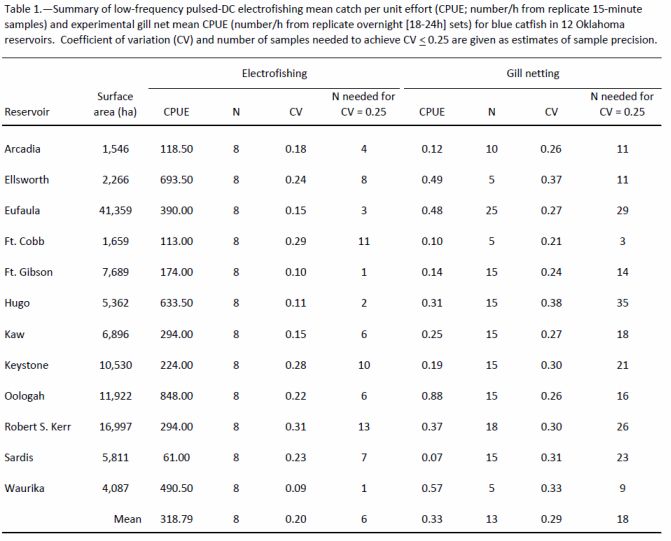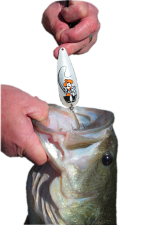Blue Catfish Sampling
This page describes two projects investigating bias in sampling blue catfish populations.
Sampling Bias of Electrofishing for Blue Catfish
(Funded by the Oklahoma Department of Wildlife Conservation through Sportfish Restoration Grant F-74-R)
Project personnel: Kris Bodine, Dan Shoup
Bodine, K.A.*, and Shoup, D.E. 2010. Capture efficiency of blue catfish electrofishing and the effects of temperature, habitat, and reservoir location on electrofishing-derived length structure indices and relative abundance. North American Journal of Fisheries Management. 30:613-621.
Bodine, K.A.*, Buckmeier, D.L., Schlechte, J.W., and Shoup, D.E. 2011. Effect of electrofishing sampling design on bias of size-related metrics for blue catfish in Reservoirs. Pages 607-620 in P.H. Michaletz and V.H. Travnichek, editors. Conservation, ecology, and management of catfish: the second international symposium. American Fisheries Society Symposium 77, Bethesda, Maryland.
Bodine, K.A., Shoup, D.E., Olive, J. Ford, Z.L., Krogman, R., and Stubbs, T.J. 2013. Catfish sampling techniques: where we are now and where we should go? Fisheries. 38(12):529-546.

Current sampling methods for blue catfish Ictalurus furcatus are suspected to be strongly size-biased, making it difficult to accurately access population density and size structure. To understand this potential bias for electrofishing in reservoirs, we conducted seasonal and habitat-specific sampling for 2 years beginning in June 2006. Kaw, Keystone, and Oologah Reservoirs in Oklahoma were sampled using 15-pps DC electricity at 1000 volts (4 amps). Temperature, habitat, and reservoir section were analyzed to determine which variables are associated with the highest total catch-per-unit-effort (CPUETotal) and CPUE of preferred length (> 762mm, TL CPUE762) blue catfish, which typically appear underrepresented in electrofishing samples.
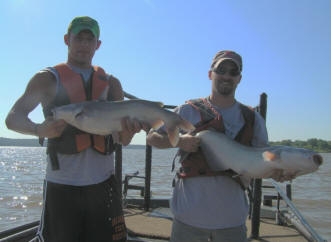
Total CPUE and CPUE762 for blue catfish was significantly (p < 0.05) higher for warmer water temperatures (> 18o C), but variability increased as temperatures exceeded 28o C. Catch rates were also significantly higher in the upper reservoir section. No difference was detected for microhabitat (channels, points, or flats). Additionally, we evaluated the actual length-specific bias of electrofishing using a population with a known length-frequency and size distribution. Approximately 300 blue catfish (approximately 25 fish from each 100-mm length class between 200 and 1000 mm) were collected and transported to a 12-ha impoundment where no blue catfish were previously present. This ‘artificial population’ was sampled to determine which length classes were more vulnerable to electrofishing. No difference in catch rate was detected for any length classes (P < 0.05) and mean total catch was less than 10 % of the total population.
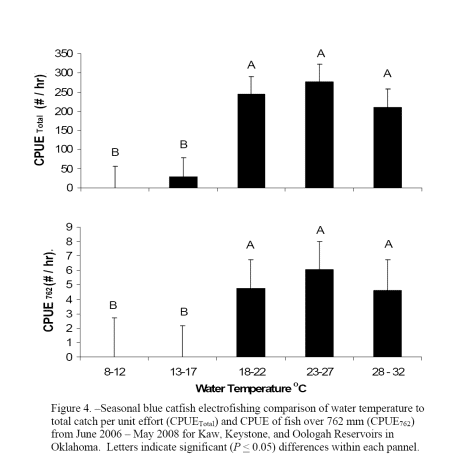
Relative Abundance and Size Structure of Blue Catfish Sampled with Electrofishing and Gill Nets
Project personnel: Nathan Evans, Dan Shoup, and Kurt Kuklinski
Evans, N.T., Shoup, D.E., and Kuklinski, K.E. 2011. Comparison of Electrofishing and Experimental Gill Nets for Sampling Size Structure and Relative Abundance of Blue Catfish in Reservoirs. In P. Michaletz and V. Travnichek, editors. Catfish 2010: Conservation, ecology, and management of catfish. American Fisheries Society Symposium, Bethesda, Maryland. in press.
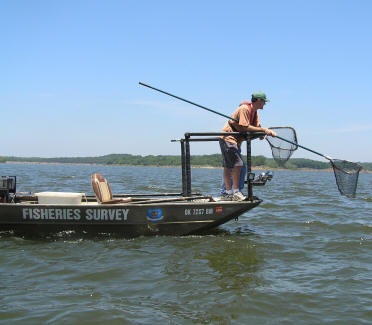
Despite increasing popularity of blue catfish Ictalurus furcatus with anglers, effective management of blue catfish has been limited due to hindered by limited information on appropriate sampling methods. We compared the efficiency and precision of low-frequency pulsed-DC electrofishing and experimental gill nets for use in estimating relative population abundance and size structure in 12 reservoirs. Electrofishing yielded greater catch rates and lower mean RSE than gill nets. Similarly, the number of samples necessary to achieve a RSE = 0.25 was lower with electrofishing in most reservoirs.
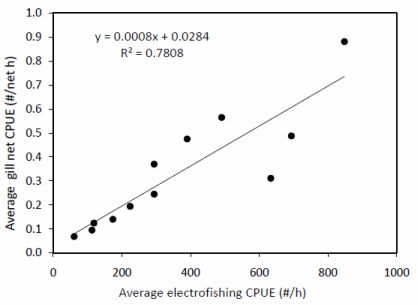
Gill net CPUE and electrofishing CPUE were strongly correlated (P < 0.01), and length-frequency distributions were also similar between gear types in many reservoirs examined. Where they differed, there was no consistent pattern, suggesting differences were due to low precision (caused by low numbers of fish captured) rather than gear bias. Our analysis indicated that both low-frequency pulsed-DC electrofishing and gill netting effectively measured relative abundance of blue catfish. In most cases, electrofishing was more efficient at estimating CPUE and size structure (requiring fewer samples to achieve comparable precision); thus we recommend using this gear when estimating these parameters for reservoir blue catfish populations.
